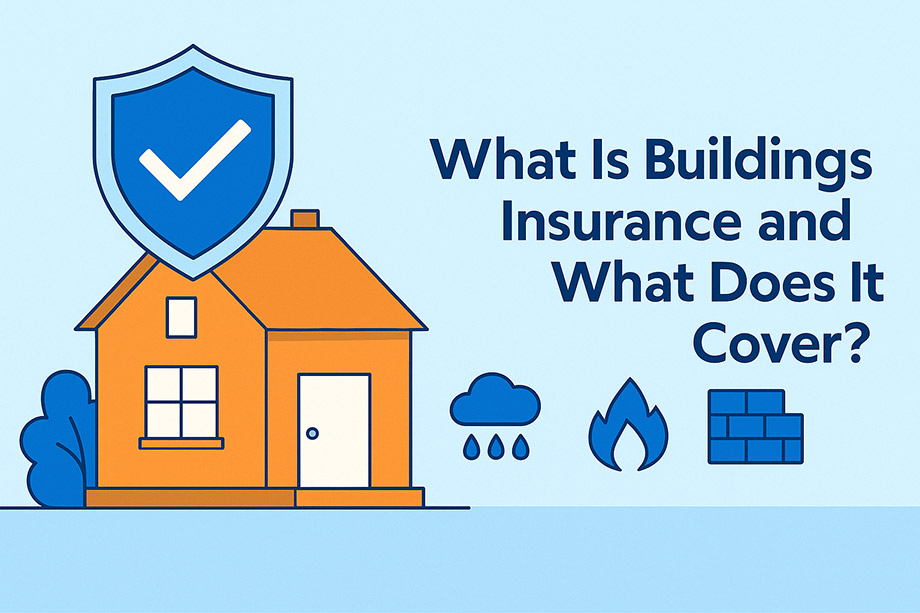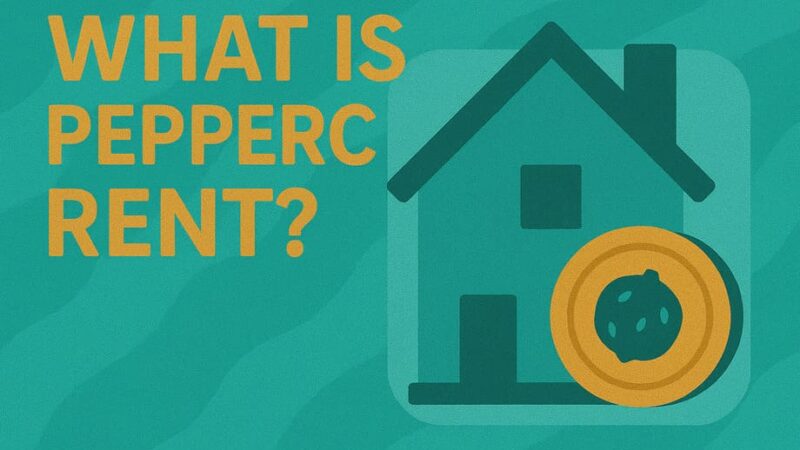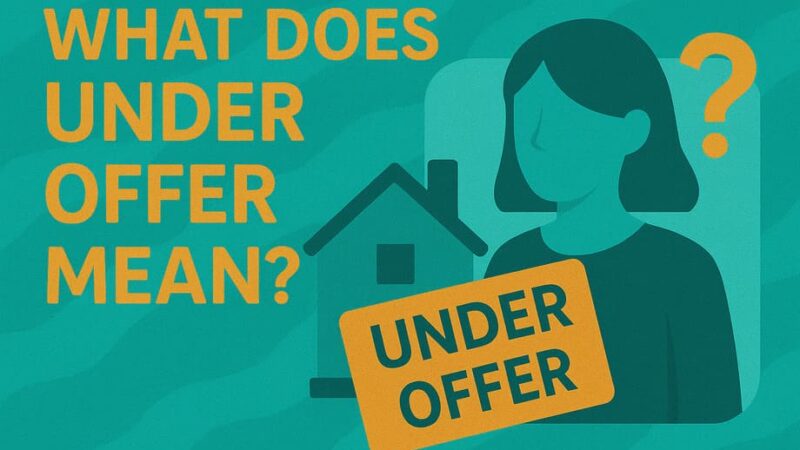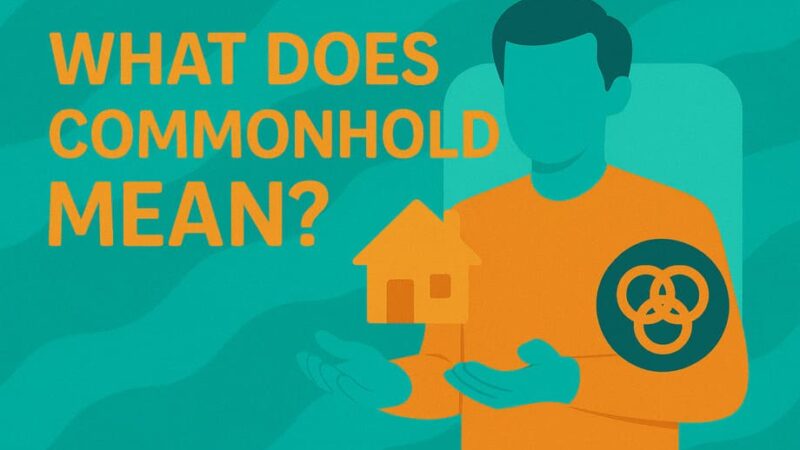What is Buildings Insurance and What Does it Cover? Complete UK Guide 2025

Buildings insurance covers the cost to repair damage to or rebuild the structure of your home, including walls, roof, windows, and permanent fixtures like fitted kitchens and bathrooms. It’s typically required by mortgage lenders and costs an average of £321 per year, providing essential protection against fire, floods, storms, and other covered events.
Whether you’re a first-time buyer trying to understand mortgage requirements or a homeowner wanting to ensure adequate protection, understanding buildings insurance is crucial. This comprehensive guide will explain exactly what buildings insurance covers, what it excludes, and why it’s one of the most important financial protections you can have.
What is Buildings Insurance?
Buildings insurance covers the cost to repair damage to or rebuild the structure of your home. This includes its windows, walls roof, outbuildings, and fitted kitchens and bathrooms. It provides cover for damage caused by events like fires, storms and floods.
Think of buildings insurance as protection for everything that would remain if you picked up your house and turned it upside down. While contents insurance protects your belongings, buildings insurance safeguards the actual structure and permanent fixtures of your property.
How Buildings Insurance Works
When you get buildings insurance, you insure the structure of your home against damage from an insured event. You’ll also be insuring the property for the full cost of rebuilding it from the ground up.
Buildings insurance works in two main ways:
- Repair Coverage: Paying for repairs to damaged parts of your home’s structure
- Rebuild Coverage: Covering the complete reconstruction of your home if it’s destroyed
As a general rule, buildings insurance covers the cost of rebuilding your house from the ground up. This sum is likely to differ from the market value of your home and often includes the cost of services such as demolition, site clearance and architects’ fees.
What Does Buildings Insurance Cover?
Core Structural Elements
Buildings insurance covers the cost of repairing damage to the structure of your property. This includes:
Main Structure:
- Walls (exterior and interior)
- Roof and roof tiles
- Windows and doors
- Floors and ceilings
- Foundations and structural supports
Permanent Fixtures and Fittings:
- Fitted kitchens and kitchen units
- Bathroom suites (baths, toilets, basins)
- Built-in wardrobes and cupboards
- Central heating systems and boilers
- Electrical wiring and plumbing
- Internal decorations and plasterwork
External Structures and Features
Depending on the type of policy you choose, you may also be covered for structures around your home, such as:
- Garages and carports
- Sheds and outbuildings
- Garden walls and fences
- Gates and boundaries
- Driveways and paths
- Swimming pools and tennis courts
- Underground pipes and cables
- Septic tanks and drainage systems
Common Covered Events
Buildings insurance usually covers loss or damage caused by:
Natural Disasters:
- Fire and lightning strikes
- Storms and high winds
- Flooding (from burst pipes or external sources)
- Earthquakes (rare in UK but covered)
- Subsidence, ground heave, and landslip
Weather-Related Damage:
- Storm damage to roofs and structures
- Flood damage from heavy rainfall
- Snow and ice damage
- Falling trees and branches during storms
Accidental and Malicious Damage:
- Theft and burglary (damage to structure)
- Vandalism and malicious damage
- Impact from vehicles or aircraft
- Accidental damage (with appropriate cover)
- Escape of water from pipes or tanks
- Escape of oil from heating systems
Additional Standard Benefits
Most comprehensive policies also include:
Alternative Accommodation: If it is unsafe to stay in your home, following flooding, for example, your insurer will cover the cost of alternative accommodation until your home is ready to live in again. Most policies will give you comparable alternative accommodation.
Emergency Access: This can cover the cost of any damage to your property caused by emergency services, for example, breaking into your home.
Loss of Keys: If you lose your keys, you can claim the cost of replacing locks on the outside of your home or repairing any alarm systems or safes inside your property.
Trace and Access: This covers the cost of removing and replacing any part of the building to find and repair a leak.
What Buildings Insurance Does NOT Cover
Standard Exclusions
There are some things that your buildings insurance will not cover. These include:
Wear and Tear: With buildings, everything from pipes to roof tiles to flooring wears down due to constant exposure and usage. Insurance companies exclude this because it’s seen as part of the inevitable life cycle of materials rather than a sudden, unforeseen event.
Maintenance Issues:
- Damage due to lack of maintenance (e.g. roof tiles not being replaced and then the roof leaking when there is a storm)
- Gradual deterioration and decay
- Damp caused by poor ventilation or maintenance
- Faulty design or poor workmanship
Mechanical and Electrical Breakdown:
- Boiler breakdowns due to age
- Electrical system failures from wear
- Mechanical breakdown of equipment
- Central heating system component failures
Specific Damage Types:
- Damage from pets or vermin
- Cosmetic damage that doesn’t affect structure
- Damage while property is empty (beyond specified periods)
- War, terrorism (unless specifically covered)
- Nuclear risks
Gradual vs. Sudden Damage
Not Covered: Gradual damp is not covered by buildings insurance, unless it’s the consequence of an event that has damaged your home and is covered (for example, storm damage to your roof).
Covered: If your leak was caused by some sort of damage to the exterior of your property, for example a storm that pulled off a lot of tiles, your home insurance may cover you.
Key Distinction: A pipe that has deteriorated over time, resulting in a slow leak and damp cannot give rise to a valid insurance claim, even if the leak or damp results in damage.
Buildings vs. Contents Insurance: What’s the Difference?
Buildings Insurance Covers:
Buildings insurance covers almost everything you wouldn’t take with you if you moved home. This includes the walls, windows and roof, as well as permanent fixtures and fittings such as baths, toilets and fitted kitchens.
- Fixed elements of the property
- Structural components
- Permanent installations
- Built-in fixtures and fittings
Contents Insurance Covers:
Buildings insurance does not cover the items inside your house, like furniture, carpets, clothes, electronics and personal items. You’ll need contents insurance to insure these.
Generally speaking, things that can be carried out of your property comes under contents insurance. This may include:
- Furniture and appliances
- Electronics and gadgets
- Clothing and personal items
- Moveable white goods
- Carpets and rugs (in most cases)
Gray Areas: What Goes Where?
Fitted Carpets: Generally covered by buildings insurance as they’re considered permanent fixtures.
Kitchen Appliances: Built-in ovens and hobs are usually buildings, while freestanding washing machines and fridges are contents.
Curtains and Blinds: Usually contents unless they’re fitted shutters or permanent installations.
Do You Need Buildings Insurance?
For Homeowners with Mortgages
If you have a mortgage, you will need buildings insurance. Mortgage providers require you to have buildings insurance that covers the total value of your mortgage.
Requirements:
- Must be in place from exchange of contracts
- Must cover at least the outstanding mortgage amount
- Lender may specify minimum coverage requirements
- Some lenders may recommend specific insurers
For Homeowners Without Mortgages
If you own your home outright, buildings insurance is not a legal requirement, but it can cover the cost of rebuilding your home if it is destroyed, which would cost you hundreds of thousands of pounds otherwise.
Why It’s Still Essential:
- Protects your largest financial asset
- Covers catastrophic rebuilding costs
- Provides peace of mind
- Relatively small cost compared to potential losses
For Different Property Types
New Build Properties: It is advisable to get buildings insurance, even if your home is newly built. The majority of newly built homes in the UK are protected by an NHBC warranty called ‘Buildmark’, which lasts for 10 years. This protection, however, is only limited to poor workmanship and does not cover accidental damage or protection against fire or flood.
Leasehold Properties: Usually, if you own a leasehold flat, the building should be insured by your landlord who owns the freehold. Your lease may say that you should have buildings insurance with a named insurer, or the freeholder may take out insurance and charge you for it.
Rental Properties: If you are a renter, you won’t need to buy buildings insurance. Instead, your landlord should arrange cover for your home. Buildings insurance is your landlord’s responsibility.
Landlord Properties: If you decide to become a landlord and rent out your property, it is still your responsibility to take out buildings insurance. This often covers malicious damage by tenants, but it’s important to double-check with your provider.
How Much Buildings Insurance Do You Need?
Understanding Sum Insured
It’s important to make sure you insure yourself for the amount it would cost to completely rebuild your home. This is called the sum insured. The cost of rebuilding your home is not the same as the price you paid for your home, or its current value if you were to sell it.
Rebuild Cost vs. Market Value:
- Rebuild costs are usually less than the current market value
- You don’t need to buy the land again
- Focus on construction costs, not property value
- Include demolition and professional fees
Calculating Rebuild Costs
Professional Assessment: To help you work out the cost of rebuilding your home, there’s a Building Cost Information Service online calculator on the Association of British Insurers’ website.
Factors to Consider:
- Size and number of rooms
- Construction materials used
- Age and architectural style
- Special features (e.g., period details)
- Current construction costs in your area
- Professional fees (architects, surveyors)
- Site clearance and demolition costs
Bedroom-Rated Cover
This estimates the cost of rebuilding your home based on the number of bedrooms you have, and is designed to protect you from under-insuring by providing very high levels of cover. With bedroom rated cover, you don’t have to worry about calculating the cost of rebuilding your home; however, you could end up over-insuring yourself and paying for cover that you might not need.
Unlimited Cover Options
Some insurers offer unlimited cover so you don’t have to work out the rebuild costs. However, if already know what they are, it may be cheaper to shop around for a policy that fits your exact needs.
How Much Does Buildings Insurance Cost?
Average Costs (2025)
The average cost of buildings insurance was £321 per year according to data from the Association of British Insurers (ABI) Household Premium Tracker, covering the period between April and June 2025. This is an average figure, so you’ll typically pay more if you have a larger or more unusual house.
Regional Variations:
- [1] 51% of customers were quoted less than £186.20 for their buildings home insurance in June 2025
- Costs vary significantly by location and risk factors
- Urban vs. rural properties may have different premiums
- High-risk areas (flooding, subsidence) cost more
Factors Affecting Cost
Property Characteristics:
- Size and number of bedrooms
- Construction materials and age
- Location and local risk factors
- Security features and improvements
- Previous claims history
Coverage Choices:
- Level of coverage selected
- Excess amount chosen
- Optional extras included
- Combined vs. separate policies
Cost-Saving Tips
Compare Providers: Insurers can charge completely different prices, so always aim to get as many quotes as possible.
Annual vs. Monthly Payments: Pay annually if you can, it normally costs more to pay monthly.
Increase Your Excess: Increase the excess – if you’re happy paying more of any claim cost yourself.
Combine Policies: Buy buildings and contents on one policy, if you need both.
Security Improvements: Install approved security systems for potential discounts.
Optional Extras and Add-Ons
Accidental Damage Cover
Accidental damage makes up over one in three claims. Some policies work out the sum insured based on a general assessment of where you live and the type and age of your home.
What It Covers:
- Putting your foot through the ceiling
- Drilling through a pipe causing a leak
- Children’s accidents damaging structure
- DIY mishaps and home improvements gone wrong
Coverage Levels:
- Basic accidental damage
- Full accidental damage cover
- Some insurers include as standard
Legal Expenses Cover
Usually gives you access to legal advice, and covers the legal costs of claiming compensation following an accident that was not your fault, as well as the cost of taking or defending other specified legal actions, such as employment or neighbour disputes.
Home Emergency Cover
This covers the cost of calling a tradesman out to deal with an emergency, such as being locked out of your home. It will cover the repairs and labour and may include overnight accommodation if you cannot stay in your home as a result.
Enhanced Coverage Options
Higher Risk Areas:
- Flooding or subsidence if you live in a high risk area
- Extended cover for period properties
- Listed building specialist cover
- Non-standard construction cover
Making a Claim: What to Expect
When to Contact Your Insurer
When something goes wrong, contact your insurer as soon as possible. Some insurers give you up to 180 days to make a claim, but the sooner you get it sorted the better.
The Claims Process
To make your claim, you may need to:
- Report the incident immediately
- Provide photographic evidence
- Get quotes for repair work
- Allow insurer’s assessor to inspect damage
- Keep receipts for emergency expenses
Important: Don’t start work or pay any tradespeople for repairs until you’ve spoken to your insurer.
What Happens Next
If your claim is accepted, your insurer will pay the costs of repairing the damage, replacing items or rebuilding the property. The amount they pay will depend on your excess and policy limits.
Typical Process:
- Initial claim assessment
- Loss adjuster appointment (for larger claims)
- Repair quotes and approval
- Work authorization and completion
- Final payment settlement
Excess Payments
Typically, you’ll need to pay a bit of the claim yourself – known as an excess – which is usually between £50 and £1,000. You choose this amount when you take out a policy.
Special Considerations
Listed Buildings and Period Properties
If your property has special features, for example a thatched roof, or it’s a listed building, you can pay for a survey from the Royal Institution of Chartered Surveyors to assess the rebuild costs.
Special Requirements:
- Higher rebuild costs due to specialist materials
- Conservation requirements and regulations
- Specialist craftsmen and techniques
- Listed building consent requirements
Non-Standard Construction
Not all houses are built the same, but what do insurers mean by ‘non standard home insurance’? Simply put, a non-standard property has walls made from something other than brick or stone and a roof made from anything other than tile or slate.
Examples Include:
- Thatched roof cottages
- Timber frame houses
- Prefabricated homes
- Properties with flat roofs
- Steel frame construction
Unoccupied Properties
If you have any questions about insuring an unoccupied building, you need buildings insurance. As long as you let us know ahead of time, your unoccupied property is covered for specific periods (typically 30-60 days) depending on your policy.
Restrictions Apply:
- Limited cover periods
- Additional security requirements
- Higher premiums may apply
- Specific exclusions for vacant properties
Home Improvements and Extensions
Remember, if you improve your home, such as adding an extension or a loft conversion, the rebuild costs may also increase and you will need to make sure you’re covered.
What to Do:
- Notify insurer before starting work
- Update sum insured if necessary
- Check if specialist cover needed during work
- Consider home renovation insurance for major projects
Frequently Asked Questions
Does Buildings Insurance Cover Subsidence?
Yes. Buildings insurance policies will cover subsidence. Most home insurers will cover the cost of damage to your property caused by subsidence. This is often limited, however, to the house itself and will not include patios, garden walls, driveways.
Are Conservatories Covered?
Yes. If you have a conservatory it will be covered by your buildings insurance. If you plan to build a new conservatory, you will need to let your insurer know to make sure you are covered.
What About Solar Panels?
Yes, solar panels are covered unless your policy schedule states otherwise as long as they are owned by you, or you are legally responsible for them and attached to the property.
Does It Cover Windows and Doors?
Yes, buildings insurance covers windows – as well as doors, fixtures and fittings, because they all count as the ‘structure of your home’. These are items you wouldn’t take with you if you moved home.
What About Roof Leaks?
It depends. If your leak was caused by some sort of damage to the exterior of your property, for example a storm that pulled off a lot of tiles, your home insurance may cover you. Where there are no signs of external damage and the leak is caused by the roof structure being worn out, your home insurance provider is unlikely to cover it, as it would fall under the wear-and-tear exclusion.
Choosing the Right Buildings Insurance
What to Look For
Coverage Completeness:
- Adequate sum insured for rebuild costs
- Comprehensive list of covered events
- Reasonable exclusions and limitations
- Alternative accommodation provision
Financial Protection:
- Insurer’s financial strength rating
- Claims payment record
- Customer service reputation
- Complaints handling performance
Value for Money:
- Competitive premiums
- Appropriate excess levels
- Useful optional extras
- Multi-policy discounts
Questions to Ask
Before choosing a policy, consider:
- Is the sum insured adequate for full rebuilding?
- What events and risks are covered?
- What are the main exclusions?
- How much is the excess?
- What optional extras are available?
- How good is the insurer’s claims service?
- Are there any restrictions for your property type?
The Importance of Buildings Insurance
For most homeowners, the value of good buildings cover is clear. Many of us would face financial ruin without this protection if something catastrophic – like a fire or flood – wrecked our homes.
Key Benefits:
- Financial Protection: Safeguards your largest asset
- Peace of Mind: Reduces worry about catastrophic events
- Mortgage Compliance: Meets lender requirements
- Comprehensive Cover: Protects against multiple risks
- Alternative Accommodation: Provides temporary housing if needed
Remember: The cheapest deal is not necessarily the best. Make sure you get the right policy, even if it costs a few pounds more.
Conclusion: Protecting Your Most Valuable Asset
Buildings insurance is one of the most important types of protection you can have as a homeowner. While it may seem like another expense, the cost of being without it could be catastrophic. With average annual premiums of around £321, buildings insurance represents exceptional value when you consider it protects assets worth hundreds of thousands of pounds.
Key Takeaways:
- Buildings insurance covers the structure and permanent fixtures of your home
- It’s typically required by mortgage lenders and recommended for all homeowners
- Coverage includes fire, flood, storm damage, and many other risks
- Rebuild cost, not market value, determines how much cover you need
- Optional extras can enhance protection for specific risks
- Comparing providers can lead to significant savings
Action Steps:
- Calculate your property’s rebuild cost accurately
- Compare quotes from multiple insurers
- Choose appropriate coverage levels and optional extras
- Review and update your policy annually
- Understand your policy terms and exclusions
- Keep your insurer informed of any property changes
Whether you’re a first-time buyer setting up your first policy or an experienced homeowner reviewing your coverage, remember that buildings insurance is not just a mortgage requirement – it’s essential protection for your home and financial security. Take time to choose the right policy, and ensure you have adequate coverage to rebuild your home completely if the worst should happen.
Final Reminder: Always read policy documents carefully, understand what is and isn’t covered, and don’t hesitate to ask your insurer questions about any aspects of your coverage you’re unsure about. Your home is likely your most valuable possession – make sure it’s properly protected.
Last Updated on August 3, 2025 by James Cartwright







